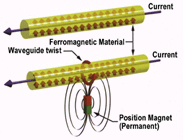Magnetostrictive
Linear Position Sensors

Magnetostriction
is a property of ferromagnetic materials such as iron, nickel,
and cobalt. When placed in a magnetic field, these materials
change size and/or shape (see Figure 1).

Figure
1
A magnetising force, H,
causes a dimensional
change due to the
alignment of magnetic domains.
The physical
response of a ferromagnetic material is due to the presence of
magnetic moments, and can be understood by considering the material
as a collection of tiny permanent magnets, or domains. Each domain
consists of many atoms.
When a material is not magnetized, the domains are randomly arranged.
When the material is magnetized, the domains are oriented with
their axes approximately parallel to one another.
Interaction of an external magnetic field with the domains causes
the magnetostrictive effect.
This effect
can be optimized by controlling the ordering of the domains through
alloy selection, thermal annealing, cold working, and magnetic
field strength.
The ferromagnetic
materials used in magnetostrictive position sensors are transition
metals such as iron, nickel, and cobalt.
In these metals, the 3d electron shell is not completely filled,
which allows the formation of a magnetic moment. (i.e., the shells
closer to the nucleus than the 3d shell are complete, and they
do not contribute to the magnetic moment). As electron spins
are rotated by a magnetic field, coupling
between the electron spin and electron orbit causes electron
energies to change. The crystal then strains so that electrons
at the surface can relax to states of lower energy. When a material
has positive magnetostriction, it enlarges when placed in a magnetic
field; with negative magnetostriction,
the material shrinks. The amount of magnetostriction in base
elements and simple alloys is small, on the order of 10-6 m/m.
Since applying
a magnetic field causes stress that changes the physical properties
of a magnetostrictive material, it is interesting to note that
the reverse is also true: applying stress to a magnetostrictive
material changes its magnetic properties (e.g., magnetic permeability).
This is called the
Villari effect.
Normal magnetostriction
and the Villari effect are both used
in producing a magnetostrictive position sensor.
 Figure 2
Figure 2
The Wiedemann effect describes
the twisting due to an axial
magnetic field applied to a
ferromagnetic wire or tube
that is carrying an electric
current.
An important
characteristic of a wire made of a magnetostrictive material
is the Wiedemann effect (see Figure 2). When an axial magnetic
field is applied to a magnetostrictive wire, and a current is
passed through the wire, a twisting occurs at the location of
the axial magnetic field. The twisting is caused by interaction
of the axial magnetic field, usually from a permanent
magnet, with the magnetic field along the magnetostrictive wire,
which is present due to the current in the wire.
The current is applied as a short-duration pulse, -1 or 2 µs;
the minimum current density is along the center of the wire and
the maximum at the wire surface. This is due to the skin effect.
The magnetic
field intensity is also greatest at the wire surface. This aids
in developing the waveguide twist. Since the current is applied
as a pulse, the mechanical twisting travels in the wire as an
ultrasonic wave. The
magnetostrictive wire is therefore called the waveguide. The
wave travels at the speed of sound in the waveguide material,
~ 3O00 m/s.
The operation
of a magnetostrictive position sensor is shown in Figure 3.

Figure 3.
The interaction of a current pulse with the position magnet
generates a strain pulse that travels down the waveguide
and is detected by the pickup element.
The axial magnetic
field is provided by a position magnet. The position magnet is
attached to the machine tool, hydraulic cylinder, or whatever
is being measured. The waveguide wire is enclosed within a protective
cover and
is attached to the stationary part of the machine, hydraulic
cylinder, etc.
The location
of the position magnet is determined by first applying a current
pulse to the waveguide. At the same time, a timer is started.
The current pulse causes a sonic wave to be generated at the
location of the position
magnet Wiedemann effect. The sonic wave travels along the waveguide
until it is detected by the pickup.
This stops
the timer. The elapsed time indicated by the timer then represents
the distance between the position magnet and the pickup.
The sonic wave
also travels in the direction away from the pickup. In order
to avoid an interfering signal from waves travelling in this
direction, their energy is absorbed by a damping device (called
the damp).
The pickup
makes use of the Villari effect. A small piece of magnetostrictive
material, called the tape, is welded to the waveguide near one
end of the waveguide. This tape passes through a coil and is
magnetized by a small permanent magnet called the bias magnet.
When a sonic wave propagates down the waveguide and then down
the tape, the stress induced by the wave causes a wave of changed
permeability (Villari effect) in the tape. This in turn causes
a change in the tape magnetic flux density, and thus a
voltage output pulse is produced from the coil (Faraday effect).
The voltage pulse is detected by the electronic circuitry and
conditioned into the desired output.
MTS magnetostrictive
sensors are available with many outputs, including DC voltage,
current, pulse width modulation, start-stop digital pulses, CANbus,
Profibus, serial synchronous interface, HART, and others.
____________________________________________________
For more
information, please contact :-
MTS Systems
Corp. USA.
Tel: 919-677-0100

